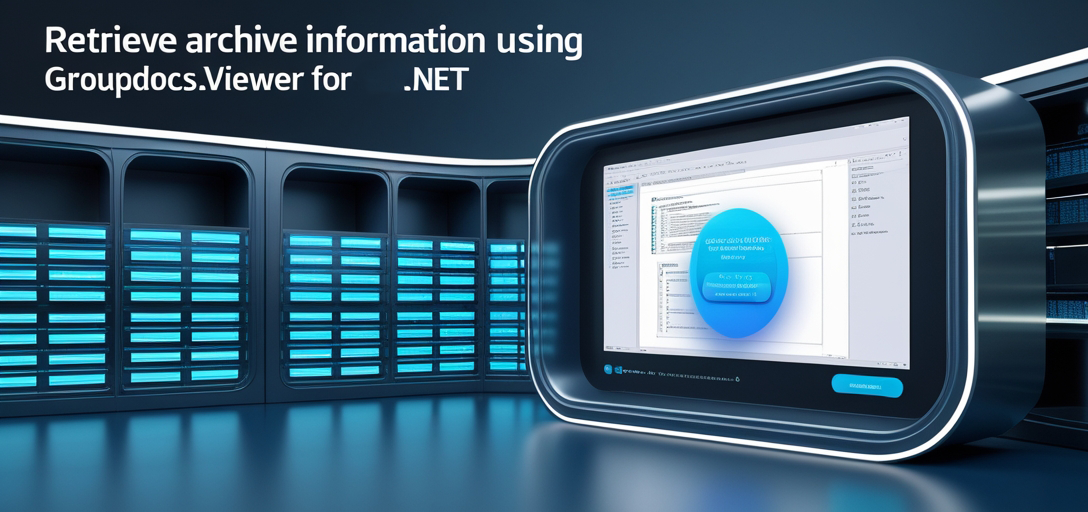How to Retrieve Archive Information Using GroupDocs.Viewer for .NET: A Comprehensive Guide
Introduction
Are you looking to efficiently extract detailed information from archive files such as ZIPs? Understanding the structure can be vital for document management. This guide will show you how to use GroupDocs.Viewer for .NET to retrieve and display comprehensive details about an archive file.

In this tutorial, we’ll cover:
- Setting up GroupDocs.Viewer in your .NET application
- Retrieving view information from archive files
- Displaying folder structures within archives
By the end of this guide, you’ll have a robust understanding of implementing these functionalities. Let’s start with what you need before diving into the code.
Prerequisites
Ensure you have the following ready:
- Libraries and Versions: Install GroupDocs.Viewer for .NET (version 25.3.0).
- Environment Setup: Use a suitable .NET development environment like Visual Studio.
- Knowledge Prerequisites: Basic understanding of C# and file handling in .NET applications.
Setting Up GroupDocs.Viewer for .NET
To use GroupDocs.Viewer for .NET, install it via NuGet Package Manager:
Installation Instructions
NuGet Package Manager Console
Install-Package GroupDocs.Viewer -Version 25.3.0
.NET CLI
dotnet add package GroupDocs.Viewer --version 25.3.0
Acquiring a License
GroupDocs.Viewer offers several licensing options:
- Free Trial: Explore basic functionalities.
- Temporary License: Full-feature access during evaluation.
- Purchase: For long-term usage, consider purchasing a license.
After installation and setting up your license, initialize GroupDocs.Viewer in your application. Here’s an example setup:
using (Viewer viewer = new Viewer("YOUR_DOCUMENT_DIRECTORY/SAMPLE_ZIP_WITH_FOLDERS"))
{
// Use the Viewer functionalities here.
}
Implementation Guide
We’ll break down the implementation into key features for a structured approach.
Retrieve View Information for Archive Files
Understanding your archive’s structure is crucial. Here’s how to achieve this:
Initialize the Viewer Object
Create an instance of the Viewer class with your archive file path:
string documentPath = "YOUR_DOCUMENT_DIRECTORY/SAMPLE_ZIP_WITH_FOLDERS";
using (Viewer viewer = new Viewer(documentPath))
{
// Your code for processing will go here.
}
Obtain View Information
Retrieve view information, formatted as JPG images:
ViewInfo info = viewer.GetViewInfo(ViewInfoOptions.ForJpgView());
Console.WriteLine("File type: " + info.FileType);
Console.WriteLine("Pages count: " + info.Pages.Count);
Display Root Folder Information
For a comprehensive overview, print the root folder details:
Console.WriteLine("Folders:");
Console.WriteLine(" - /");
Recursively Read and Print Subfolder Names
To explore subfolders within your archive, use this recursive method:
string rootFolder = string.Empty;
ReadArchiveFolders(viewer, rootFolder);
private static void ReadArchiveFolders(Viewer viewer, string folder)
{
ViewInfoOptions options = ViewInfoOptions.ForJpgView();
options.ArchiveOptions.Folder = folder;
ArchiveViewInfo viewInfo = viewer.GetViewInfo(options) as ArchiveViewInfo;
foreach (string subFolder in viewInfo.Folders)
{
Console.WriteLine($" - {subFolder}");
ReadArchiveFolders(viewer, subFolder);
}
}
Practical Applications
GroupDocs.Viewer for .NET can be used in various scenarios:
- Document Management Systems: Automatically extract and display archive structures.
- Content Delivery Platforms: Provide previews of archived content to users.
- Data Analysis Tools: Analyze folder hierarchies within archives for business insights.
Integration with other frameworks like ASP.NET or WPF is straightforward, allowing seamless incorporation into existing systems.
Performance Considerations
For optimal performance:
- Optimize Resource Usage: Efficiently manage memory and handle large files.
- Memory Management Best Practices: Dispose of
Viewerobjects properly to free up resources promptly.
Conclusion
In this tutorial, you’ve learned how to utilize GroupDocs.Viewer for .NET to retrieve detailed information from archive files. Implementing these features can significantly enhance your document management capabilities.
Next Steps
Consider exploring more advanced features offered by GroupDocs.Viewer or integrating it with other components of your application. Experiment with different file types and complex folder structures to deepen your understanding.
FAQ Section
What is the purpose of
ViewInfoOptions?- It configures how you want to view a document, such as rendering specific formats like JPG.
How do I handle large archives efficiently?
- Use memory management techniques and dispose of resources properly.
Can GroupDocs.Viewer process password-protected files?
- Yes, with the correct license and configuration, it can handle encrypted documents.
Is there a limit to the archive file size that can be processed?
- The limit depends on your system’s memory capacity; larger files require more resources.
How do I integrate GroupDocs.Viewer with ASP.NET applications?
- Use the Viewer class within your controller actions or services, similar to how you would in a console application.